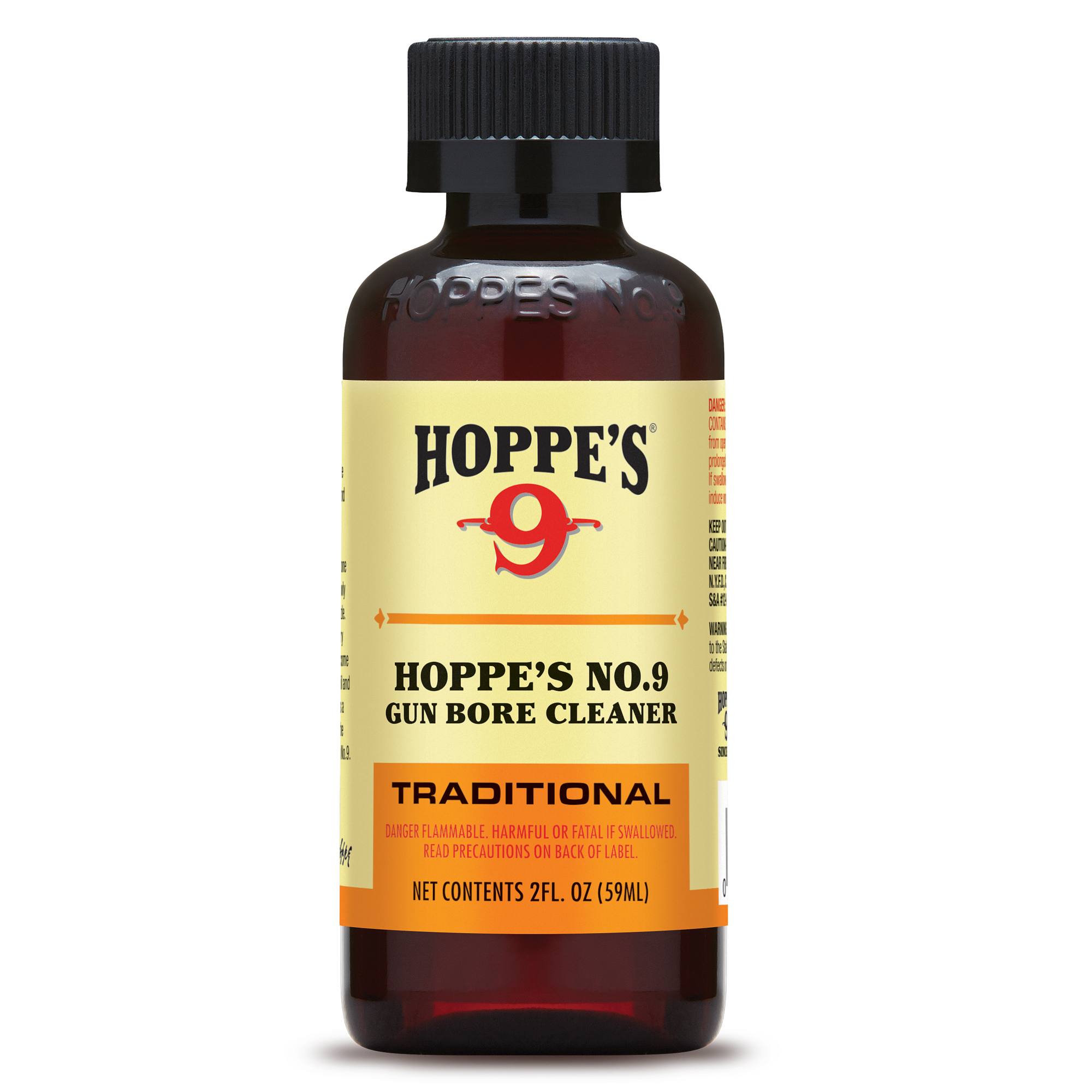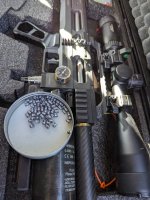team Ghost...appreciate the discussion....here is hoping that I can get the ft-lbs down enough that my Gammo pull string resettable targets won't get bent from the impact ...
Upvote 0
Yes, I highly recommend you clean the barrel thoroughly. I ALWAYS use a bronze brush to thoroughly scrub all the stubborn protective coatings the manufacturers apply to barrels before shipping. It took me around 60 (quick) strokes (forward and reverse) with the bronze brush dipped in solvent and many patches (like over 50) to remove the coatings on each of my guns -- BRK Ghost, Kalibrgun Cricket, Air Arms S410 Extra, Air Arms TX200, AirForce, etc. After cleaning, I give my barrels a good polish to remove the burrs that can strip out lead from pellets and accumulate in the choke. Lastly, I wipe all the cleaning agents with rubbing alcohol.Team Ghost, from what I have been reading and watching...I want to at a minimum clean the barrel(s) before using as it seems they can have some anti rust coatings ...do I also want to polish them? So excellent how to, do not do videos out there.
If you ordered the 177 hp I don’t think you will be able to get it to 12 fpe but you can get it to shoot 13 gr jsb very well below 20 fpe with what they are now calling the med hammer spring.Hello, I order the HP so ...to your point...I am expecting 23" barrels.
tc
Thank you! I remember reading many years ago to "never" use a any metal brush on air-rifle barrels...so when I clean my R9 and Revere I use the cotton mops with Ballistol, with the carbon fiber (rotatable) cleaning rod....followed by patches with Ballistol and then dry patches......that brass brush definitely will get the job done quicker than cotton mops...Yes, I highly recommend you clean the barrel thoroughly. I ALWAYS use a bronze brush to thoroughly scrub all the stubborn protective coatings the manufacturers apply to barrels before shipping. It took me around 60 (quick) strokes (forward and reverse) with the bronze brush dipped in solvent and many patches (like over 50) to remove the coatings on each of my guns -- BRK Ghost, Kalibrgun Cricket, Air Arms S410 Extra, Air Arms TX200, AirForce, etc. After cleaning, I give my barrels a good polish to remove the burrs that can strip out lead from pellets and accumulate in the choke. Lastly, I wipe all the cleaning agents with rubbing alcohol.
Cleaning the barrel on the Ghost is simple and doesn't require removal. Cleaning from the breech end is just a matter of removing the pellet probe and inserting the cleaning rod into the hole from which the probe exits and guiding it to the breech.
Below are what I use. The cleaning rod is carbon fiber and made by Tipton and twists to follow the barrel's rifling. (Hint: It's easier to determine the twist rate of a barrel when using a brush as opposed to patches because the brush engages the rifling better.)View attachment 393179
Is that a function of barrel length? Would the 17" "plus" barrel shorten the time the pellet is in the barrel enough to get down to 12 ftlb? I can see my dream of my backyard FT course is getting way more expensive....If you ordered the 177 hp I don’t think you will be able to get it to 12 fpe but you can get it to shoot 13 gr jsb very well below 20 fpe with what they are now calling the med hammer spring.
Yes the longer barrel adds 40-50 fps with the same settings over the 17” one. Your targets should withstand 20 fpe though the 10 yard 1 will take the most damage but after that it should be fine. Gammo targets are what a lot of ft events use and are regularly shot at 20 fpeIs that a function of barrel length? Would the 17" "plus" barrel shorten the time the pellet is in the barrel enough to get down to 12 ftlb? I can see my dream of my backyard FT course is getting way more expensive....
I don’t believe any of the nonsense about bronze brushes damaging barrels, like I don’t believe many of the things said by supposed experts, especially on YouTube. I’ve been using them for many years and use vigorous forward and reverse strokes through my airgun barrels because lead can get embedded onto their steel surfaces (which I discovered through my AA TX200), which only the bronze brushes can remove. The result after cleaning, as I’ve told another member here, is my guns hitting the cojones of flies at 35 yards.Thank you! I remember reading many years ago to "never" use a any metal brush on air-rifle barrels...so when I clean my R9 and Revere I use the cotton mops with Ballistol, with the carbon fiber (rotatable) cleaning rod....followed by patches with Ballistol and then dry patches......that brass brush definitely will get the job done quicker than cotton mops...
So do you have a technique or know of an accurate video to watch regarding polishing?I don’t believe any of the nonsense about bronze brushes damaging barrels, like I don’t believe many of the things said by supposed experts, especially on YouTube. I’ve been using them for many years and use vigorous forward and reverse strokes through my airgun barrels because lead can get embedded onto their steel surfaces (which I discovered through my AA TX200), which only the bronze brushes can remove. The result after cleaning, as I’ve told another member here, is my guns hitting the cojones of flies at 35 yards.Also, after polishing my barrels, they rarely, if ever, need to be cleaned. Since polishing my Cricket’s barrel, it has been shooting spot-on to this day, in which around more than 70 tins of 500-count pellets have gone through it.
I just run a cleaning rod tipped with a mop applied with polishing paste (JB bore paste) vigorously back and forth with the mop exiting the muzzle/crown (contrary to the advice of many). I'd do that for around 300 strokes or so in total before cleaning all the paste with a bronze brush dipped in solvent and wiping dry with alcohol-moistened patches. Job done.So do you have a technique or know of an accurate video to watch regarding polishing?
As I am about to get a Ghost...which solvent do you use? Since you have a known method, that can hit fly nutz at 35 yards...I will duplicate it! thanks, tcI don’t believe any of the nonsense about bronze brushes damaging barrels, like I don’t believe many of the things said by supposed experts, especially on YouTube. I’ve been using them for many years and use vigorous forward and reverse strokes through my airgun barrels because lead can get embedded onto their steel surfaces (which I discovered through my AA TX200), which only the bronze brushes can remove. The result after cleaning, as I’ve told another member here, is my guns hitting the cojones of flies at 35 yards.Also, after polishing my barrels, they rarely, if ever, need to be cleaned. Since polishing my Cricket’s barrel, it has been shooting spot-on to this day, in which more than 70 tins of 500-count pellets have gone through it.
I use Hoppe’s bore cleaner, which in my experience has been the most effective solvent for lead, copper, and carbon removal.As I am about to get a Ghost...which solvent do you use? Since you have a known method, that can hit fly nutz at 35 yards...I will duplicate it! thanks, tc


Team Ghost,
Finally getting some quality time with my new Ghost HP 177, and i realize the hammerspring adj doesn’t do anything…doest change velocity regardless of regulator pressure…i tried to find online “fix” for this and failed..anybody know how to fix this? I took the top off and can see when i turn the dial the spring gets slightly more or less compressed depending on direction…but again no vel change when cycled..
Such a wealth of knowledge and so helpful. I'm sure I am not the only one who appreciates it so much.If the wheel isn't affecting your fps it is because your reg is set so that it is the power limiting factor in the whole system.
You're hitting the valve harder with increased hammer spring tension (via adjusting the wheel) but the reg is so low that the harder tap on the valve simply isn't doing anything. Increase the reg pressure and you'll see that the wheel effects velocity.
Reg on mine is 128ish and does the following, all with same reg pressure.....
MIN = 19.9fpe with 13.73 pellets (805fps)
"11" = 29.5fpe with 15.89 pellets (915-920fps)
MAX = 32-33fpe with 18.9 slugs (875-880fps)
I don't shoot them this fast, but MAX with 13.73gr pellets is 1040fps, MIN is 805, so a 235fps difference. Same 128bar reg pressure for both speeds, only difference is the hammer tension (power wheel).